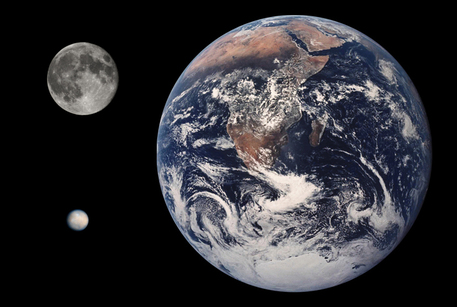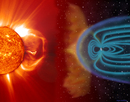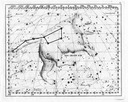Ceres – not large enough to be a 'real' planet
Where is the planet between Mars and Jupiter?
From ancient times, scientists have attempted to identify laws governing the orbits of the planets. In 1766, the physicist and mathematician Johann Daniel Titius developed a formula that can be used to derive the distances between the planets and the Sun with only a small degree of inaccuracy. It was publicized by the director of the Berlin observatory at the time, Johann Elert Bode, and is therefore called the 'Titius-Bode law'.
 © NASA
|
This to-scale composite photograph shows the planet Earth, the Earth's moon and the asteroid Ceres. The latter has been classified as a dwarf planet since 2006.
However, according to this empirical (that is, derived from observations) formula another planet should be present between Mars and Jupiter. This prediction was an incentive for many astronomers to try to find this as-yet unknown heavenly body. A 'sky police force' was even formed to carry out a systematic search. It was rather by coincidence that in 1801 the Italian astronomer Giuseppe Piazzi discovered the expected planet in the area that the calculation had forecast: Ceres.
Ceres – not large enough to be a 'real' planet.
With a diameter of almost 600 miles, Ceres is considerably smaller than the other planets and soon after its discovery many other even smaller heavenly bodies (over 50 000 to date) were found in orbits between Mars and Jupiter. Ceres lost its status as a planet and is now called a planetoid or asteroid, as are the other bodies.
The assumption that it was the leftover debris of a larger planet also turned out to be wrong. Now we know that there was never a real planet at this location. Due to the gravity of the largest planet, Jupiter, the orbits of the asteroids were continually disturbed and they could never form a large planet.
Some small asteroids have hardly changed since they were formed around 4.6 billion years ago. Others have combined into larger asteroids such as Ceres. Since 2006, Ceres has officially been classified as a dwarf planet.
German Aerospace Center
Ceres – not large enough to be a 'real' planet.
With a diameter of almost 600 miles, Ceres is considerably smaller than the other planets and soon after its discovery many other even smaller heavenly bodies (over 50 000 to date) were found in orbits between Mars and Jupiter. Ceres lost its status as a planet and is now called a planetoid or asteroid, as are the other bodies.
The assumption that it was the leftover debris of a larger planet also turned out to be wrong. Now we know that there was never a real planet at this location. Due to the gravity of the largest planet, Jupiter, the orbits of the asteroids were continually disturbed and they could never form a large planet.
Some small asteroids have hardly changed since they were formed around 4.6 billion years ago. Others have combined into larger asteroids such as Ceres. Since 2006, Ceres has officially been classified as a dwarf planet.
German Aerospace Center
Ceres – not large enough to be a 'real' planet
Where is the planet between Mars and Jupiter?
From ancient times, scientists have attempted to identify laws governing the orbits of the planets. In 1766, the physicist and mathematician Johann Daniel Titius developed a formula that can be used to derive the distances between the planets and the Sun with only a small degree of inaccuracy. It was publicized by the director of the Berlin observatory at the time, Johann Elert Bode, and is therefore called the 'Titius-Bode law'.
 © NASA
|
This to-scale composite photograph shows the planet Earth, the Earth's moon and the asteroid Ceres. The latter has been classified as a dwarf planet since 2006.
However, according to this empirical (that is, derived from observations) formula another planet should be present between Mars and Jupiter. This prediction was an incentive for many astronomers to try to find this as-yet unknown heavenly body. A 'sky police force' was even formed to carry out a systematic search. It was rather by coincidence that in 1801 the Italian astronomer Giuseppe Piazzi discovered the expected planet in the area that the calculation had forecast: Ceres.
Ceres – not large enough to be a 'real' planet.
With a diameter of almost 600 miles, Ceres is considerably smaller than the other planets and soon after its discovery many other even smaller heavenly bodies (over 50 000 to date) were found in orbits between Mars and Jupiter. Ceres lost its status as a planet and is now called a planetoid or asteroid, as are the other bodies.
The assumption that it was the leftover debris of a larger planet also turned out to be wrong. Now we know that there was never a real planet at this location. Due to the gravity of the largest planet, Jupiter, the orbits of the asteroids were continually disturbed and they could never form a large planet.
Some small asteroids have hardly changed since they were formed around 4.6 billion years ago. Others have combined into larger asteroids such as Ceres. Since 2006, Ceres has officially been classified as a dwarf planet.
German Aerospace Center
Ceres – not large enough to be a 'real' planet.
With a diameter of almost 600 miles, Ceres is considerably smaller than the other planets and soon after its discovery many other even smaller heavenly bodies (over 50 000 to date) were found in orbits between Mars and Jupiter. Ceres lost its status as a planet and is now called a planetoid or asteroid, as are the other bodies.
The assumption that it was the leftover debris of a larger planet also turned out to be wrong. Now we know that there was never a real planet at this location. Due to the gravity of the largest planet, Jupiter, the orbits of the asteroids were continually disturbed and they could never form a large planet.
Some small asteroids have hardly changed since they were formed around 4.6 billion years ago. Others have combined into larger asteroids such as Ceres. Since 2006, Ceres has officially been classified as a dwarf planet.
German Aerospace Center








